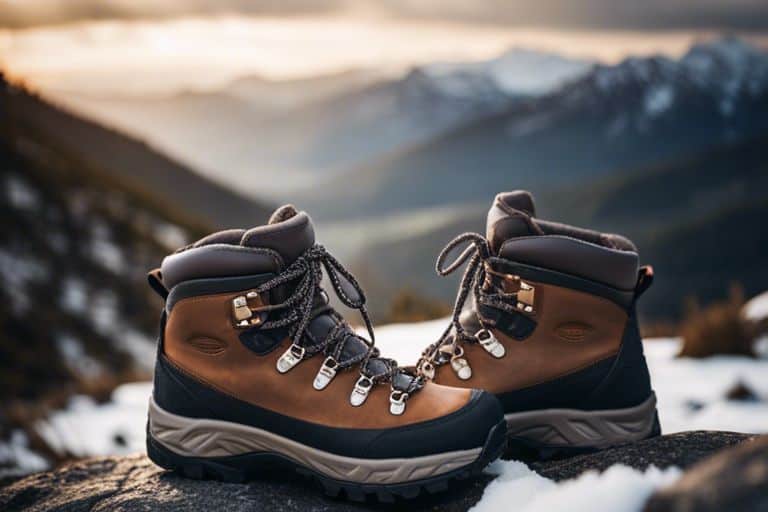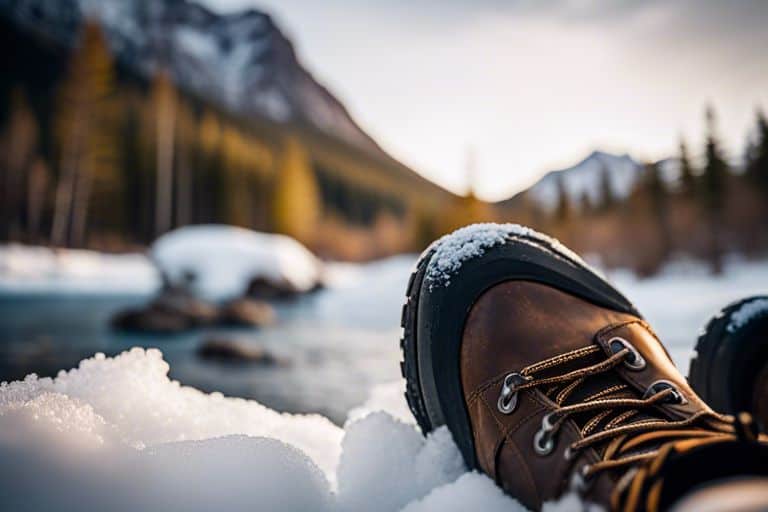Are you an avid hiker looking to conquer those treacherous winter trails? Choosing the right footwear for slippery winter hiking trails is crucial to ensure your safety and enjoyment during your outdoor adventures. As the terrain becomes icy and snow-covered, it is essential to equip yourself with the proper footwear that offers reliable traction and protection against the elements. In this guide, you will learn how to select the right footwear that will keep you safe and comfortable on slippery winter hiking trails.
When it comes to winter hiking, the right footwear can make all the difference in preventing slips and falls, keeping your feet warm and dry, and providing the necessary support for challenging terrain. By following these tips, you will be able to confidently choose the best footwear for your winter hiking adventures, allowing you to explore with peace of mind.
Key Takeaways:
- Choose durable and water-resistant material: Look for hiking boots made from materials like Gore-Tex or leather to keep your feet dry and protected from the elements.
- Opt for a sturdy outsole: A reliable grip is essential for navigating slippery trails, so prioritize footwear with deep lugs and a strong, supportive outsole.
- Consider insulation and warmth: Look for boots with insulation to keep your feet warm in icy conditions, but be mindful of breathability to prevent overheating.
- Ensure proper ankle support: High-cut hiking boots or shoes with good ankle support are crucial for stability and preventing injuries on uneven terrain.
- Fit is key: Take your time to find the right size and fit for your hiking footwear, as a snug and comfortable fit is essential for a successful winter hike.


Factors to Consider When Choosing Winter Hiking Footwear
If you are gearing up for a winter hiking adventure, you need to make sure you have the right footwear to keep you safe and comfortable on those slippery trails. When choosing the perfect winter hiking footwear, there are several important factors to consider:
- Traction and Grip: The ability of the outsole to provide solid grip on slippery surfaces is crucial for winter hiking. You need footwear with a deep lug pattern and aggressive tread to ensure you have the traction you need on icy and snowy trails.
- Boot Insulation and Warmth: Keeping your feet warm is essential for winter hiking. Look for insulated boots with features like Thinsulate or PrimaLoft to ensure your feet stay warm and comfortable in cold temperatures.
- Water Resistance and Breathability: Winter hiking often involves encountering snow and slush, so having waterproof and breathable footwear is important. Look for boots with a Gore-Tex or similarly waterproof and breathable membrane to keep your feet dry and comfortable.
- Fit and Comfort: A proper fit is crucial for winter hiking footwear. Ensure that the boots are comfortable and provide enough room for thick socks without feeling too tight. A good fit will prevent blisters and discomfort on long hikes.
- Durability and Build Quality: Winter hiking can be tough on footwear, so durability is a key consideration. Look for boots with high-quality construction and materials that can withstand the rigors of winter hiking.
Any winter hiking footwear you choose should meet these criteria to ensure you have a safe and enjoyable hiking experience.
Understanding Traction and Grip
When it comes to winter hiking, the need for solid traction and grip cannot be overstated. Slippery winter trails can pose a serious risk of falls and injuries, so having boots with a deep lug pattern and aggressive tread is essential for keeping you safe on the trail. Look for outsoles specifically designed for winter conditions, with features like self-cleaning lugs to prevent snow and ice buildup. The right traction will give you the confidence to tackle even the most treacherous winter terrain.
Boot Insulation and Warmth
Keeping your feet warm in cold winter conditions is crucial for a comfortable and enjoyable hiking experience. Insulated boots with materials like Thinsulate or PrimaLoft provide the warmth you need without adding unnecessary bulk. Look for boots with an appropriate level of insulation for the conditions you will be hiking in to ensure your feet stay warm and comfortable throughout your adventure.
Water Resistance and Breathability
Encountering snow and slush is inevitable when winter hiking, so having waterproof and breathable footwear is a must. Look for boots with a Gore-Tex membrane or similar waterproof and breathable technology to keep your feet dry and comfortable in wet winter conditions. The waterproofing will keep moisture out, while breathability will prevent your feet from getting sweaty and uncomfortable during long hikes.
Fit and Comfort
A proper fit is crucial for winter hiking footwear. Comfortable boots with enough room for thick socks will prevent discomfort and blisters on long winter hikes. Make sure the boots provide adequate support and cushioning to keep your feet comfortable throughout your adventure. Prioritize a good fit to ensure maximum comfort and safety on the trail.
Durability and Build Quality
Winter hiking can be tough on footwear, so durable construction and high-quality materials are essential for longevity and performance. Look for boots made with durable materials and solid construction to withstand the rigors of winter hiking. A well-built boot will provide the support and protection you need for many winter adventures to come.
Footwear Technologies and Features
Despite the winter conditions, hiking on slippery trails can be made safer and more enjoyable with the right footwear. There are several technologies and features to consider when choosing the appropriate footwear for hiking in these conditions. By understanding the innovative tread designs for slippery surfaces, the role of spikes and crampons, and the importance of midsole support and cushioning, you can make an informed decision on the footwear that will best suit your needs.
Innovative Tread Designs for Slippery Surfaces
When hiking on slippery winter trails, having the right tread design on your footwear can be a game-changer. Look for outsoles with deep lugs and aggressive tread patterns, as these will provide better traction on snow and ice. Some manufacturers also incorporate specialized rubber compounds that remain flexible in cold temperatures, ensuring better grip. In addition, self-cleaning lugs can prevent snow and mud build-up, maintaining traction with each step.
The Role of Spikes and Crampons
For particularly treacherous terrain, consider footwear that is compatible with spikes or crampons. Spikes are small, removable metal studs that can be attached to your footwear for additional traction on icy surfaces, while crampons are more rugged and have longer spikes for use on steep, icy terrain. These devices can greatly improve your stability and safety on icy trails, but it’s important to note that they should be used with caution on rocky or uneven ground to avoid injury.
Midsole Support and Cushioning
When navigating slippery winter trails, the proper midsole support and cushioning is crucial for your comfort and safety. Look for footwear with a supportive midsole that provides stability and reduces the risk of foot fatigue, especially on uneven or icy terrain. Additionally, adequate cushioning in the midsole can absorb shock and provide insulation from the cold ground. A good balance of support and cushioning will help you maintain a steady and comfortable stride, reducing the risk of slips and falls on winter hiking trails.
How to Assess the Right Boot for Your Needs
Not all hiking boots are created equal, especially when it comes to navigating slippery winter hiking trails. When choosing the right footwear, it’s important to consider a few key factors that are crucial for your safety and comfort on the trail. Here’s how to assess the right boot for your needs.
Evaluating Trail Conditions and Terrain
First and foremost, you need to consider the specific trail conditions and terrain you’ll be hiking on. Slippery or icy trails require boots with superior traction, such as those with Vibram soles or aggressive lug patterns. Waterproofing is also important, as wet conditions can make the trail even more treacherous. Look for boots with a Gore-Tex lining or other waterproof materials to keep your feet dry and comfortable.
Personal Hiking Style and Preferences
Your personal hiking style and preferences will also play a significant role in determining the right boot for you. If you prefer a lightweight, flexible boot for better agility and maneuverability on the trail, you may opt for a hiking shoe or a mid-height boot. On the other hand, if ankle support and stability are your top priorities, a high-cut boot with sturdy ankle support may be the better choice for you. Consider the length and difficulty of your hikes, as well as your individual comfort and fit preferences when evaluating these factors.
Tips for Trying on and Testing Footwear
To ensure that you are getting the right footwear for slippery winter hiking trails, it is important to try on and test the options available to you. Here are some tips to help you make the most informed decision:
- Make sure you try on both hiking boots or shoes with the socks you intend to wear while hiking. This will give you a better sense of how they will fit and feel on the trail.
- Walk around the store in the boots to check for any potential pressure points or discomfort. You should also try walking on both flat surfaces and inclined ramps to mimic the conditions you will experience on the winter hiking trails.
- Pay attention to how the boots or shoes feel on your heels, arches, and toes, as proper support in these areas is crucial for stability and comfort on slippery trails.
The last step in trying on and testing footwear for winter hiking is to ensure that you feel confident in your choice. The right footwear can make all the difference when navigating slippery and challenging hiking trails.
What to Wear When Trying on Hiking Boots
When trying on hiking boots, it’s important to wear the appropriate socks and clothing. You should wear the same type of socks you plan to wear while hiking, as this will give you the most accurate fit. Additionally, wearing moisture-wicking clothing will help prevent any discomfort or chafing while testing out different boots. This will ensure that you can make a more informed decision about which boots will be most comfortable for your winter hiking adventures.
Performing In-Store Tests for Traction and Support
While trying on hiking boots, you should perform a few in-store tests to assess the traction and support they provide. Start by walking on both flat surfaces and inclined ramps to gauge how well the boots grip the ground. Additionally, try some side-to-side movements to ensure that the boots provide the necessary stability for winter hiking. These tests will help you determine whether the boots will offer the performance you need on slippery trails.
Understanding Boot Sizing and Footbed Options
When trying on hiking boots, it’s important to have a good understanding of boot sizing and the options available for footbeds. Pay attention to how the boots fit in terms of length, width, and volume, as well as the available options for customizable footbeds. Understanding these details will help you select the most comfortable and supportive boots for your winter hiking adventures.
How to Care for and Maintain Your Winter Hiking Footwear
Your winter hiking footwear goes through a lot, especially when tackling slippery trails. To ensure they last and continue to provide the support and protection you need, it’s important to know how to properly care for and maintain them. Here are some key tips to help you keep your winter hiking footwear in top condition.
Proper Cleaning and Storage
After a winter hike, your boots are likely to be covered in mud, snow, and salt. To properly clean them, start by removing any excess dirt or debris with a soft brush or cloth. For stubborn stains, use a mild soap and water solution, being sure to rinse thoroughly. Once clean, allow your boots to air dry away from direct heat sources. It’s also important to store your boots in a cool, dry place away from direct sunlight to prevent any damage to the materials.
Waterproofing and Conditioners
Keeping your footwear waterproof is essential for winter hiking. Regularly applying a waterproofing treatment will help maintain the integrity of the boot’s materials, keeping your feet dry and warm. There are numerous waterproofing products available, including sprays, waxes, and conditioners. Be sure to follow the manufacturer’s instructions for the best results. Additionally, using a leather conditioner will help keep the leather supple and prevent it from drying out and cracking.
When to Repair or Replace Your Boots
Regular maintenance can only do so much, and there may come a time when your winter hiking boots need to be repaired or replaced. Signs of excessive wear and tear, such as separation of the sole from the upper, significant tread wear, or loss of waterproofing, are indicators that it may be time for a replacement. Similarly, if you notice any discomfort or lack of support from your boots, it’s important to consider replacing them to avoid injury. Remember, your safety on the trails is essential, and having reliable footwear is crucial for a successful winter hike.
Safety Tips for Hiking on Slippery Winter Trails
Now that you’re prepared with the right footwear for hiking on slippery winter trails, it’s important to also be equipped with the knowledge of how to stay safe in these conditions. Here are some safety tips to keep in mind:
- Always check the weather and trail conditions before you go, and be sure to plan your route accordingly to avoid hazards caused by ice and snow.
- Wear multiple layers of clothing to protect yourself from the cold, and bring extra clothing in case you get wet.
- Make sure to tell someone about your hiking plans and estimated return time so they can alert authorities if necessary.
- Carry essential safety gear, such as a map, compass, first aid kit, and a headlamp in case you get caught after dark.
- Stay on marked trails and avoid going off the beaten path, especially in areas known for avalanche risk.
After considering these safety tips, you can confidently embark on your winter hiking adventure knowing you’re well-prepared for any challenges that may come your way.
How to Navigate Ice and Snow-Covered Paths
When hiking on ice and snow-covered paths, it’s important to adjust your stride and pace. Taking shorter, more deliberate steps will help you maintain better footing and reduce the risk of slipping. Additionally, consider using crampons or ice cleats that can be attached to your boots for added traction. Be extra cautious when crossing icy areas, and always use trekking poles or a walking stick for added stability.
Using Trekking Poles and Other Accessories
One of the most valuable accessories for navigating slippery winter hiking trails is a pair of good quality trekking poles. Trekking poles can provide added stability and support, especially when going downhill on icy terrain. They can also help you test the stability of the ground as you move forward. Additionally, consider using gaiters to keep snow out of your boots, and invest in insulated, waterproof gloves to keep your hands warm and dry.
How to Choose the Right Footwear for Slippery Winter Hiking Trails
Presently, you have learned about the importance of choosing the right footwear for slippery winter hiking trails. It is crucial to prioritize safety and comfort when selecting your winter hiking shoes or boots. Remember to look for boots with good traction and ankle support to help prevent slips and falls. Insulated, waterproof shoes or boots are also essential for keeping your feet warm and dry in cold, wet conditions. To further educate yourself on proper footwear for winter walking, you can refer to this comprehensive winter safety guide provided by West Virginia University: PROPER FOOTWEAR FOR WINTER WALKING.
By investing in the right footwear for winter hiking, you can enhance your outdoor experience and stay safe on slippery trails. With the proper shoes or boots, you can confidently navigate through icy and snowy terrain, enjoying the beauty of winter while minimizing the risk of accidents. Remember to consider the terrain, weather conditions, and your own comfort when making your footwear selection for winter hiking, and always prioritize safety above all else.
FAQ
Q: Why is it important to choose the right footwear for slippery winter hiking trails?
A: Choosing the right footwear for slippery winter hiking trails is crucial for maintaining stability and reducing the risk of slips and falls. Proper footwear provides traction and support, which are essential for safe hiking in winter conditions.
Q: What features should I look for in winter hiking footwear to ensure traction on slippery trails?
A: Look for winter hiking footwear with a sturdy and aggressive outsole tread pattern, such as deep lugs or multi-directional cleats, to provide maximum traction on slippery surfaces. Additionally, consider footwear with features like heel brakes and forefoot grooves for added stability.
Q: Should I choose waterproof or water-resistant footwear for winter hiking?
A: It’s advisable to choose waterproof footwear for winter hiking, as it will keep your feet dry and protect them from cold and moisture. Wet feet can lead to discomfort and increase the risk of frostbite in cold temperatures.
Q: Is insulation an important factor to consider when choosing winter hiking footwear?
A: Yes, insulation is an important factor to consider, especially for hiking in snowy or icy conditions. Look for footwear with insulation, such as Thinsulate or PrimaLoft, to keep your feet warm and comfortable during winter hikes.
Q: Are there any additional tips for choosing the right footwear for slippery winter hiking trails?
A: In addition to traction, waterproofing, and insulation, consider the fit and support of the footwear. Look for a snug fit to prevent blisters and ensure stability, as well as ankle support to reduce the risk of twisting or spraining your ankle on uneven or slippery terrain.



0 Comments